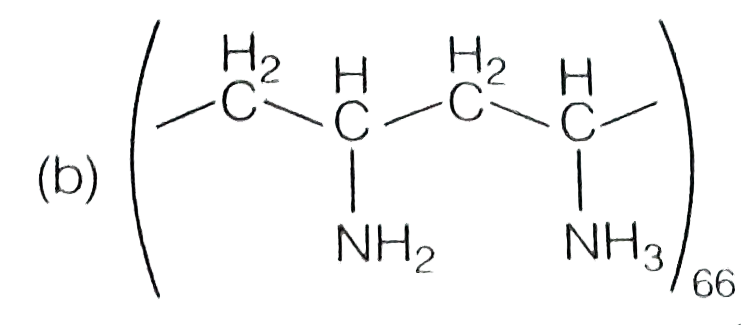Which one of the following represent nylon 6,6 polymer?




The correct Answer is:D
To determine which structure represents the Nylon-6,6 polymer, we need to understand its composition and formation. Here's a step-by-step solution:
Step 1: Identify the Monomers
Nylon-6,6 is a type of polyamide formed from two specific monomers:
1. Adipic Acid: This is a dicarboxylic acid with the formula HOOC-(CH2)4-COOH.
2. Hexamethylenediamine: This is a diamine with the formula H2N-(CH2)6-NH2.
Step 2: Understand the Polymerization Process
Nylon-6,6 is synthesized through a condensation polymerization reaction between the two monomers. In this process:
- The carboxylic acid group (-COOH) from adipic acid reacts with the amine group (-NH2) from hexamethylenediamine.
- This reaction results in the formation of an amide bond (-CO-NH-) and releases a molecule of water (H2O).
Step 3: Write the Structure of Nylon-6,6
The repeating unit of Nylon-6,6 can be represented as follows:
- The backbone consists of alternating carbon and nitrogen atoms due to the amide linkages.
- The structure can be depicted as:
- COO-(CH2)4-CO-NH-(CH2)6-NH
Step 4: Identify the Correct Representation
From the options provided in the question, we need to look for the structure that reflects the repeating unit of Nylon-6,6, which includes:
- The amide linkages
- The correct number of carbon atoms (6 from each monomer)
Conclusion
The correct representation of the Nylon-6,6 polymer is the structure that shows the alternating amide linkages and the correct number of carbon atoms from both monomers.
Final Answer
The correct option that represents the Nylon-6,6 polymer is Option D.
---
Nylon-6,6 is a type of polyamide formed from two specific monomers:
1. Adipic Acid: This is a dicarboxylic acid with the formula HOOC-(CH2)4-COOH.
2. Hexamethylenediamine: This is a diamine with the formula H2N-(CH2)6-NH2.
Nylon-6,6 is synthesized through a condensation polymerization reaction between the two monomers. In this process:
- The carboxylic acid group (-COOH) from adipic acid reacts with the amine group (-NH2) from hexamethylenediamine.
- This reaction results in the formation of an amide bond (-CO-NH-) and releases a molecule of water (H2O).
The repeating unit of Nylon-6,6 can be represented as follows:
- The backbone consists of alternating carbon and nitrogen atoms due to the amide linkages.
- The structure can be depicted as:
- COO-(CH2)4-CO-NH-(CH2)6-NH
From the options provided in the question, we need to look for the structure that reflects the repeating unit of Nylon-6,6, which includes:
- The amide linkages
- The correct number of carbon atoms (6 from each monomer)
The correct representation of the Nylon-6,6 polymer is the structure that shows the alternating amide linkages and the correct number of carbon atoms from both monomers.
The correct option that represents the Nylon-6,6 polymer is Option D.
Similar Questions
Knowledge Check
- Question 1 - Select One
Which one of the following is not a condensation polymer?
AGlyptalBdacronCNeopreneDMelamine - Question 2 - Select One
Which one of the following structures represents the neoprene polymer?
A⎛⎜⎝−CH2−C∣Cl=CH−CH2−⎞⎟⎠nB⎛⎜⎝−CH2−CH∣CN−⎞⎟⎠nC⎛⎜⎝−CH2−CH∣Cl−⎞⎟⎠nD⎛⎜ ⎜⎝−CH∣C6H5−CH2−⎞⎟ ⎟⎠n - Question 3 - Select One
Which of the following structure represents neoprene polymer?
A⎛⎜⎝−CH2−CN∣CH−⎞⎟⎠nB⎛⎜⎝−CH2−Cl∣CH−⎞⎟⎠nC⎛⎜ ⎜⎝−CH∣C6H5−CH2−⎞⎟ ⎟⎠nD⎛⎜⎝−CH2−C∣Cl=CH−CH2−⎞⎟⎠n
Which one of the following is not a natural polymer
View SolutionWhich one of the following is not a polyamide polymers:
(a) Nylon-6,6
(b) Nylon-6,10
( c) Glylptal
(d) DacronView SolutionWhich one of the following is a chain growth polymer?
View SolutionWhich of the following structures represents neoprene polymers?
View SolutionWhich one of the following polymers in not obtained by condensation polymerisation ?
View Solution

